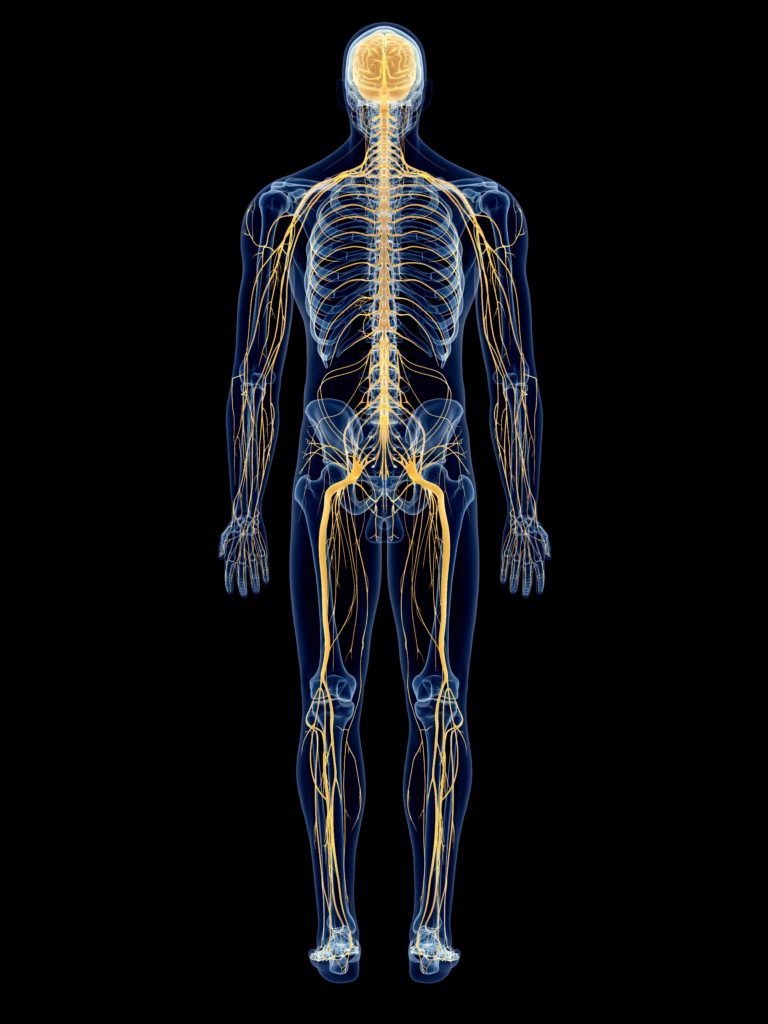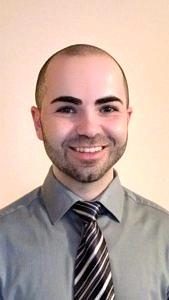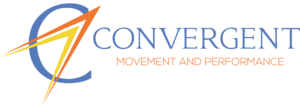Nerves

Nerves control all aspects of our body, and greatly influence what occurs in our mind. They play a significant role in controlling our muscles, movements, sensations, pain experience, and overall ability to perform daily, recreational, and athletic activities.
In other words, you wouldn’t even be able to lift your arm if your nerves didn’t communicate that command properly with the appropriate muscles.
Your nerves are always actively involved regardless of whether you want to increase strength, improve muscle flexibility, optimize technique and movement quality in a daily, recreational, or sport skill, or if you want to reduce pain or swelling and improve recovery.
Therefore it is always absolutely crucial to determine exactly what role your nerves are playing within any condition, movement, or performance goal.
Nerve Stressors
There are normal and abnormal stressors that result in different outcomes on nerves. Nerves are commonly loaded and stressed during activities that move, stretch, compress, rub, cut, or electrify the nerve. In addition, nerves are stressed by our thoughts and emotions.
The way by which nerves adapt to stressors is dependent on the nature of the stressor, as well as the recovery process post stressor.
Please remember, challenging obstacles from which you are able to fully recover result in a good stress known as Eustress. On the other hand, obstacles deemed threatening and/or obstacles from which you are unable to fully recover will result in a negative stress known as Distress.
Distress: A Dangerous Threat to Nerves
Inappropriate loading and stress consisting of excessive compression or stretching, rubbing, radiation, electricity, or laceration resulting from a knife, injection, or surgical complication may result in nerve injury.
Excessive compression may be caused by bone such as the case with stenosis of the spine or bone spurs surrounding the regions by which a nerve passes, spinal disc impairments such as disc herniation, and tight muscles or excessive bleeding or swelling through which the nerve travels.
Please pay particular attention to the last point on excessive bleeding or swelling, which may occur from a separate non-nerve related injury. For instance, it is very common to see an ankle sprain resulting in swelling which ends up compressing as well as irritating surrounding nerves leading to increased and prolonged pain and poor movement.
In other words, please remember that nerve injury, irritation, or sensitivity may likely be involved in some way with almost all conditions involving pain, injury, and poor movement. After all, nerves pass through and control everything within our body.
In regards to negative stress due to stretching of a nerve, not only may a nerve be stretched too much, but it can also be moved and stretched too little.
Some level of nerve movement, gliding, and lengthening occurs with all motion that the human body is able to perform. This movement is not only normal, but necessary for proper nerve function.
It is very common to see individuals that spend excessive periods of time in certain positions such as sitting, who then do not spend equal amounts of time in opposite postures and positions such as standing, walking, and running, experience poor mobility of certain nerves while experiencing excessive stretching stress on other nerves.
Remember, it’s all about balance!
Furthermore, a nerve may become sensitive if stressed, physically or emotionally, for prolonged periods of time. This particular condition is far more common than many realize, and treatment often looks far different than the treatment for many of the other types of nerve conditions and injuries.
The most common nerve conditions seen at Convergent Movement and Performance are due to compression (something pushing on the nerve), poor mobility of the nerve, and/or nerve sensitivity.
Resolve What's Holding You Back: Restoration and Recovery
The following includes general information on the stages and progression of healing after injury or trauma. Please keep in mind that this is just a guide and general description for the normal healing process.
The time frames listed here apply to the average individual, however may differ for your particular case. General health, activity level, and the severity of the injury all influence your rate of healing.
For instance, individuals of younger age, better physical shape, and/or individuals with no other co-morbidities or medical conditions will likely heal at a much faster rate when compared to individuals of older age, poor physical shape and body composition, that are smokers, and/or those that have additional medical conditions such as (but not limited to) high blood pressure, high cholesterol, and diabetes.
Secondly, a lower grade injury will likely heal at a faster rate than a higher grade injury. If you have sustained an injury, please be sure to consult with a licensed healthcare provider that can help individualize your rehabilitation program.
If surgery was performed, the surgeon will be able to provide more specific information and details regarding expected time frames for healing and return to activity. Make sure to follow your surgeon’s instructions carefully.
Phase 1: Acute phase
The acute phase begins immediately after the injury or surgery. The purpose of this phase is to protect the nerve and avoid placing additional stress onto the nerve.
Splinting, bracing, and immobilization may potentially be required to maximize protection. This is not common unless there was a severe injury or if surgery was performed.
Certain movements may be permitted, and even beneficial, depending on the extent of the injury and if surgery was performed.
Specific information regarding appropriate and inappropriate movement will be provided by your licensed healthcare provider.
Convergent Movement and Performance performs a thorough assessment on each individual to determine whether and which specific movements, positions, and postures increase nerve stress and which decrease nerve stress.
This will allow for specific instructions and a detailed home program on exactly which movements to perform and which to avoid.
Phase 2: Recovery phase
The recovery phase begins when the muscle that is supplied by the nerve is able to contract, and sensation controlled by that nerve has begun to be experienced again.
This phase continues to focus on avoiding movements, positions, and postures that increase excessive nerve stress while continuously performing the movements, positions, and postures that decrease nerve stress.
Once deemed appropriate by your healthcare provider, gentle movement of the nerve will be introduced.
At Convergent Movement and Performance, we begin by utilizing hands-on manual therapy techniques to glide, or “floss” your nerve in a specialized manner that promotes movement, blood flow, nutrition, and healing to the nerve without stretching or increasing stress. As the nerve continues to heel and is prepared for increased stress, the gliding techniques will gradually incorporate mild and non-harmful forms of stretching/tensioning to promote mobility of the nerve.
It is normal and not harmful to reproduce some discomfort while performing activities that gently stress the nerve, however there must not be any lasting or lingering pain afterwards. It is important to self-assess your pain 2 hours, 12 hours, and 24 hours after the symptom-reproducing activity. There should be no lingering symptoms at those points.
If lingering pain did result, than the stress was too great; but not necessarily damaging so please do not be frightened.
It would be appropriate to return to activities performed in the acute stage until these increased lingering symptoms subside.
In addition, there will be a significant emphasis on re-training functional movement patterns in a way that minimize stress onto the nerve. Specific activities will be introduced that focus on gradually retraining the muscles supplied by the nerve, as well as re-establishing normal sensation within the region supplied by that nerve.
Phase 3: Return to Function phase
The return to function phase begins when normal sensation and strength has returned, and pain has stabilized and is no longer limiting your ability to perform daily activity. Focus will be placed on optimizing mobility, strength, and sensation.
Fitness, sporting, and other physical and recreational activity will begin to be re-introduced in this phase, with emphasis on maintaining the most optimal technique and movement patterning during activity in order to maintain nerve health.
Eustress: A Healthy Challenge for Nerves
Nerves may be stressed and loaded appropriately when they undergo movement, gliding, stretching, rubbing, various compressive and shear forces, and even electrical stimulation (such as with TENS units) as long as all of those stressors are within the limits of what the particular nerve can handle.
Nerves are loaded and stressed often throughout the day with everyday activities that involve movement of your body. Stressing the nerves is not dangerous unless the stress is beyond the limits of what that nerve can handle.
Time to Move Forward: Preparation and Fitness
Improving fitness is among the most effective approaches addressing the ‘preparation’ aspect of performance enhancement. Preparing for maximal performance through fitness involves optimizing the balance between movement quality, strength, endurance, and speed.
Focusing on movement quality prepares you to perform activities in a way that avoids excessive stress on your nerves.
Focusing on strength prepares your nerves to work more efficiently.
Focusing on endurance improves blood flow and nutrition to your nerves.
Focusing on speed improves how quickly your nerves are able to communicate with the rest of your body.
TAKE ACTION!
- Please take the time to reflect on the fact that your nerves may be affected in some way or another regardless of the type of injury you have experienced.
- If you believe you have undergone a nerve-related injury, be sure to consult with a licensed healthcare provider specializing in this field in order to receive a definitive diagnosis rather than attempting to “guess and test.”
- Upon initial nerve injury, it may be appropriate to avoid any activities that directly stress your nerve. Focus on your postures and daily movement habits, and be sure to follow the recommendations provided by your healthcare provider.
- It is time to begin the ‘preparation’ aspect of performance enhancement as soon as sufficient restoration of any nerve-related distress has occurred. When ready, begin implementing the information presented in this article, as well as the remainder of the content within the “Convergent Path to Performance,” in order to maximize Eustress while minimizing Distress.
Summary
Nerves control all aspects of your body, highly influence your mind, and undergo a multitude of stressors throughout the day. The key is to remember that you hold massive influence over the health of your nerves. By understanding how nerves are stressed and recover, you will have the tools necessary to maximize positive adaptation while reducing the occurrence of distress and injury.

Dr. Eugene Ketselman PT, DPT, Cert. MDT, CSCS
Dr. Eugene Ketselman is a licensed Physical Therapist, Certified Strength and Conditioning Specialist, Performance Coach, and owner of Convergent Movement and Performance; Home of where Physical Therapy, fitness, and performance training converge! Dr. Ketselman's mission is to help motivated athletes and active adults excel in their passions by maximizing physical performance and reducing setbacks from pain and injury.
Here at Convergent Movement and Performance, we practice what we preach. You know we are a good match for one another as soon as you find yourself relating to the content we provide. Be sure to click below to learn more.
Do you have specific questions that aren’t answered on this website?
Click below
Does pain, weakness, or exhaustion prevent you from reaching your FULL potential while performing the activities you love?
Click below
Do you love what you’re seeing, but still aren’t sure if you can make the commitment?
Click below
Contact Us
Convergent Movement and Performance serves out of Northern – Central New Jersey, conveniently located to those that live, work, and travel in the nearby towns of Warren, Bridgewater, Martinsville, Watchung Hills, Bedminster, Basking Ridge, Bernardsville, Chatham, Westfield, and Piscataway within Somerset, Morris, Union, and Middlesex counties, NJ.
